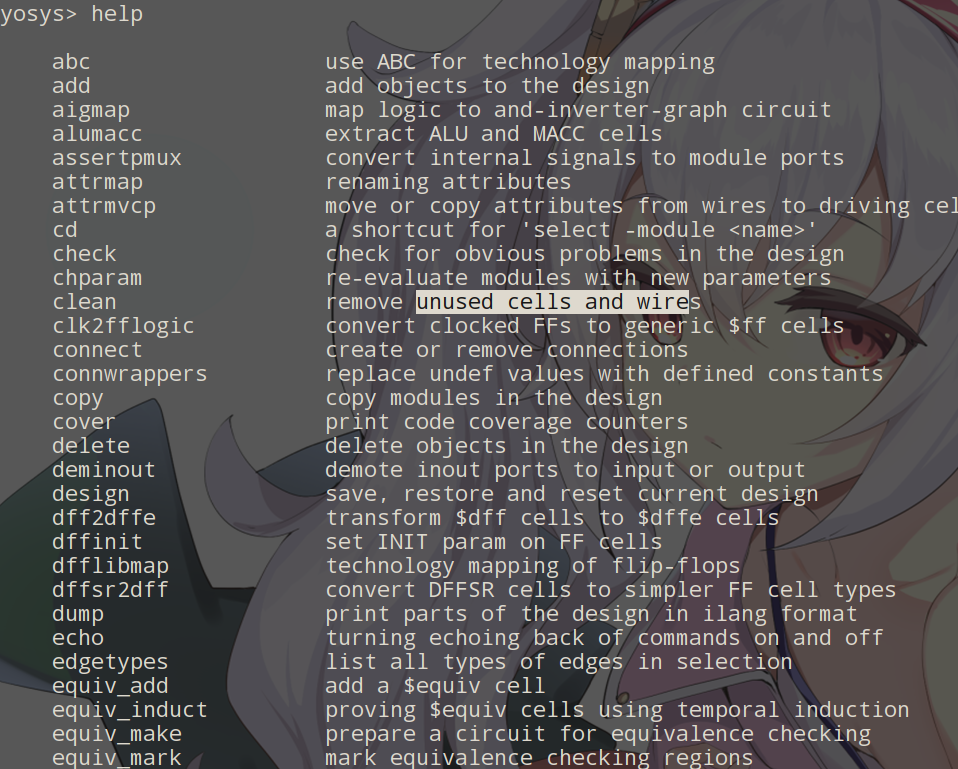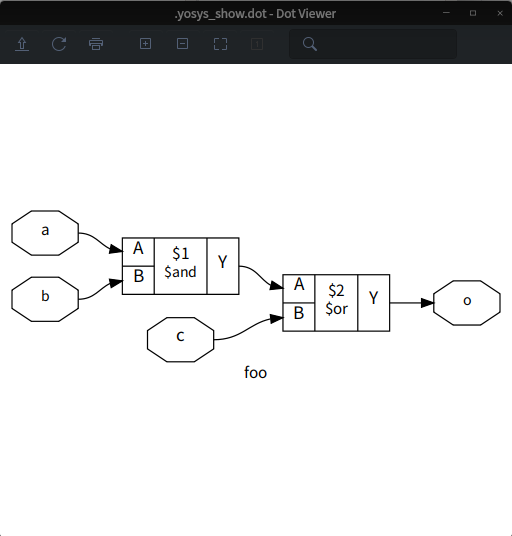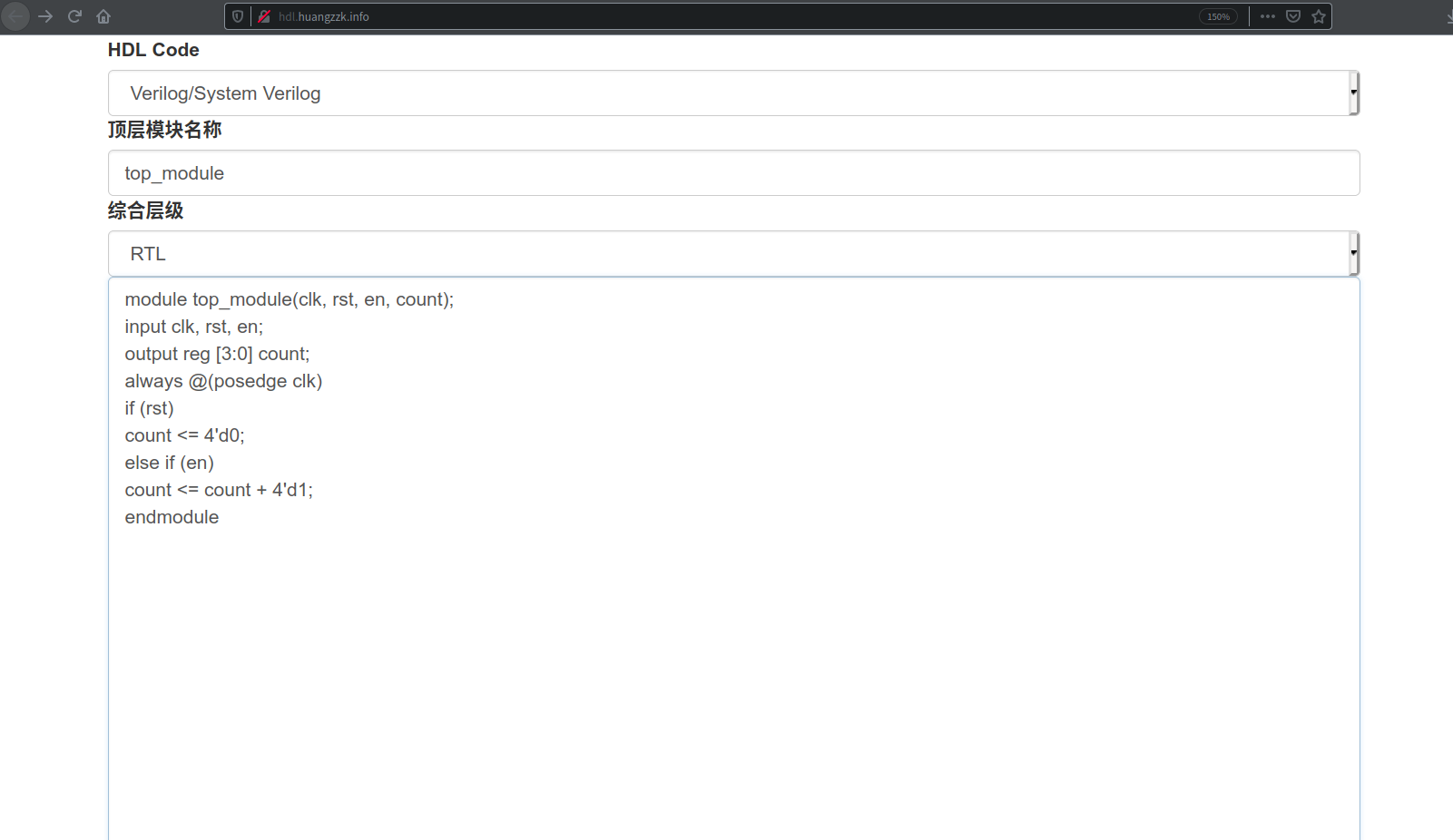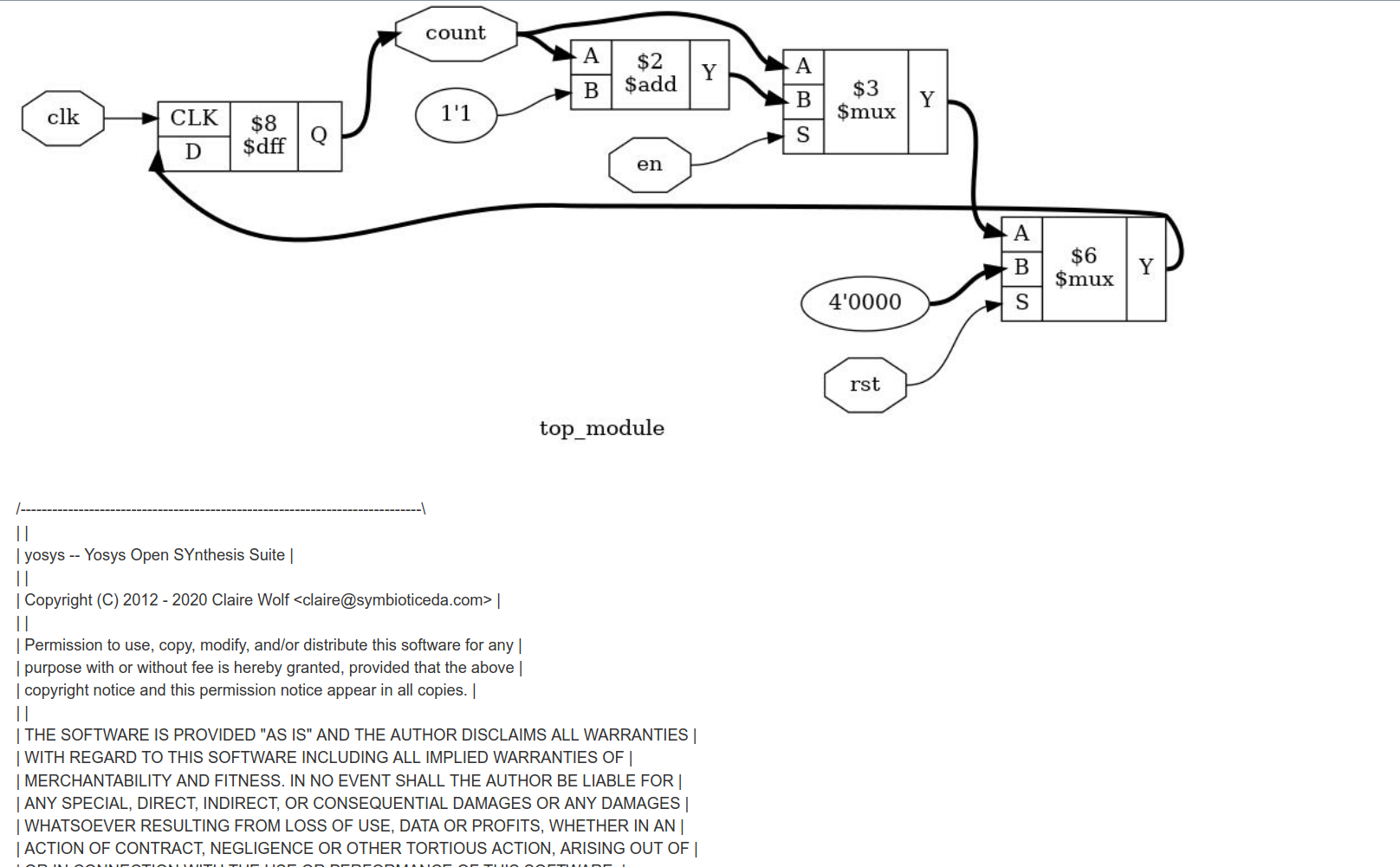[TOC]
## 介绍
Yosys是Verilog RTL综合的框架。它目前具有广泛的Verilog-2005支持,并为各种应用程序领域提供了一组基本的综合算法。所选功能和典型应用:
* 处理几乎所有可综合的Verilog-2005设计
* 将Verilog转换为BLIF / EDIF / BTOR / SMT-LIB /简单的RTL Verilog /等等
* 内置的形式检查属性和等效性的方法
* 映射到ASIC标准单元库(自由文件格式)
* 映射到Xilinx 7系列和Lattice iCE40 FPGA
* 自定义流程的基础和/或前端
通过使用合成脚本组合现有过程(算法)并根据需要通过扩展Yosys C ++代码库添加其他过程,可以使Yosys适于执行任何综合工作。 <br/>
Yosys是根据ISC许可(与MIT许可或2子BSD许可类似的GPL兼容许可)许可的免费软件。<br/>
事实上,yosys是一个解释器,就如同python的解释器一样,于是从理论上我们可以在linux使用sheban来写脚本运行!
[文档推荐]([https://www.kutu66.com/GitHub/article\_94386](https://www.kutu66.com/GitHub/article_94386))
## 在deepin上的安装
**首先安装所需要的依赖项目**
```bash
sudo apt-get install build-essential clang bison flex \
libreadline-dev gawk tcl-dev libffi-dev git \
graphviz xdot pkg-config python3 libboost-system-dev \
libboost-python-dev libboost-filesystem-dev zlib1g-dev
```
**安装yosys**
使用一下命令进行安装
```bash
sudo apt-get install yosys
```
## 关于帮助
对于不同版本的yosys,有些命令可能不同,yosys是一个解释器,可以在终端输入`yosys`进入,然后输入`help`查看支持的命令!

## 分步说明一个简单的例子
**新建`foo.v`文件,文件内容如下所示**
```
module foo (
input a,
input b,
input c,
output o
);
assign o = (a & b) | c;
endmodule
```
**终端切换到yosys解释器,终端输入yosys即可**
```
yosys
```
**读入待分析的verilog文件**
当然根据版本的不同可能read要换成 read_verilog.
```
yosys> read -sv foo.v
1. Executing Verilog-2005 frontend.
Parsing SystemVerilog input from `foo.v' to AST representation.
Generating RTLIL representation for module `\foo'.
Successfully finished Verilog frontend.
```
**指出顶层模块**
```
yosys> hierarchy -top foo
2. Executing HIERARCHY pass (managing design hierarchy).
2.1. Analyzing design hierarchy..
Top module: \foo
2.2. Analyzing design hierarchy..
Top module: \foo
Removed 0 unused modules.
```
**将设计以Yosys的内部格式写入控制台**
```
yosys> write_ilang
3. Executing ILANG backend.
Output filename: <stdout>
# Generated by Yosys 0.8 (git sha1 5706e90)
autoidx 3
attribute \top 1
attribute \src "foo.v:1"
module \foo
attribute \src "foo.v:8"
wire $and$foo.v:8$1_Y
attribute \src "foo.v:8"
wire $or$foo.v:8$2_Y
attribute \src "foo.v:2"
wire input 1 \a
attribute \src "foo.v:3"
wire input 2 \b
attribute \src "foo.v:4"
wire input 3 \c
attribute \src "foo.v:5"
wire output 4 \o
attribute \src "foo.v:8"
cell $and $and$foo.v:8$1
parameter \A_SIGNED 0
parameter \A_WIDTH 1
parameter \B_SIGNED 0
parameter \B_WIDTH 1
parameter \Y_WIDTH 1
connect \A \a
connect \B \b
connect \Y $and$foo.v:8$1_Y
end
attribute \src "foo.v:8"
cell $or $or$foo.v:8$2
parameter \A_SIGNED 0
parameter \A_WIDTH 1
parameter \B_SIGNED 0
parameter \B_WIDTH 1
parameter \Y_WIDTH 1
connect \A $and$foo.v:8$1_Y
connect \B \c
connect \Y $or$foo.v:8$2_Y
end
connect \o $or$foo.v:8$2_Y
end
```
**将流程(always块)转换为网表元素并执行一些简单的优化**
```
yosys> proc; opt
4. Executing PROC pass (convert processes to netlists).
4.1. Executing PROC_CLEAN pass (remove empty switches from decision trees).
Cleaned up 0 empty switches.
4.2. Executing PROC_RMDEAD pass (remove dead branches from decision trees).
Removed a total of 0 dead cases.
4.3. Executing PROC_INIT pass (extract init attributes).
4.4. Executing PROC_ARST pass (detect async resets in processes).
4.5. Executing PROC_MUX pass (convert decision trees to multiplexers).
4.6. Executing PROC_DLATCH pass (convert process syncs to latches).
4.7. Executing PROC_DFF pass (convert process syncs to FFs).
4.8. Executing PROC_CLEAN pass (remove empty switches from decision trees).
Cleaned up 0 empty switches.
5. Executing OPT pass (performing simple optimizations).
5.1. Executing OPT_EXPR pass (perform const folding).
5.2. Executing OPT_MERGE pass (detect identical cells).
Finding identical cells in module `\foo'.
Removed a total of 0 cells.
5.3. Executing OPT_MUXTREE pass (detect dead branches in mux trees).
Running muxtree optimizer on module \foo..
Creating internal representation of mux trees.
No muxes found in this module.
Removed 0 multiplexer ports.
5.4. Executing OPT_REDUCE pass (consolidate $*mux and $reduce_* inputs).
Optimizing cells in module \foo.
Performed a total of 0 changes.
5.5. Executing OPT_MERGE pass (detect identical cells).
Finding identical cells in module `\foo'.
Removed a total of 0 cells.
5.6. Executing OPT_RMDFF pass (remove dff with constant values).
5.7. Executing OPT_CLEAN pass (remove unused cells and wires).
Finding unused cells or wires in module \foo..
removed 1 unused temporary wires.
Removed 0 unused cells and 1 unused wires.
5.8. Executing OPT_EXPR pass (perform const folding).
5.9. Finished OPT passes. (There is nothing left to do.)
```
**使用xdot显示设计网表**
```
yosys> show
```
显示结果如下:

同样的实现,使用gv可用以下命令实现:
```
yosys> show -format ps -viewer gv
```
**将网表转换为门逻辑并执行一些简单的优化**
```
yosys> techmap; opt
7. Executing TECHMAP pass (map to technology primitives).
7.1. Executing Verilog-2005 frontend.
Parsing Verilog input from `<techmap.v>' to AST representation.
Generating RTLIL representation for module `\_90_simplemap_bool_ops'.
Generating RTLIL representation for module `\_90_simplemap_reduce_ops'.
Generating RTLIL representation for module `\_90_simplemap_logic_ops'.
Generating RTLIL representation for module `\_90_simplemap_compare_ops'.
Generating RTLIL representation for module `\_90_simplemap_various'.
Generating RTLIL representation for module `\_90_simplemap_registers'.
Generating RTLIL representation for module `\_90_shift_ops_shr_shl_sshl_sshr'.
Generating RTLIL representation for module `\_90_shift_shiftx'.
Generating RTLIL representation for module `\_90_fa'.
Generating RTLIL representation for module `\_90_lcu'.
Generating RTLIL representation for module `\_90_alu'.
Generating RTLIL representation for module `\_90_macc'.
Generating RTLIL representation for module `\_90_alumacc'.
Generating RTLIL representation for module `\$__div_mod_u'.
Generating RTLIL representation for module `\$__div_mod'.
Generating RTLIL representation for module `\_90_div'.
Generating RTLIL representation for module `\_90_mod'.
Generating RTLIL representation for module `\_90_pow'.
Generating RTLIL representation for module `\_90_pmux'.
Generating RTLIL representation for module `\_90_lut'.
Successfully finished Verilog frontend.
Mapping foo.$and$foo.v:8$1 ($and) with simplemap.
Mapping foo.$or$foo.v:8$2 ($or) with simplemap.
No more expansions possible.
8. Executing OPT pass (performing simple optimizations).
8.1. Executing OPT_EXPR pass (perform const folding).
8.2. Executing OPT_MERGE pass (detect identical cells).
Finding identical cells in module `\foo'.
Removed a total of 0 cells.
8.3. Executing OPT_MUXTREE pass (detect dead branches in mux trees).
Running muxtree optimizer on module \foo..
Creating internal representation of mux trees.
No muxes found in this module.
Removed 0 multiplexer ports.
8.4. Executing OPT_REDUCE pass (consolidate $*mux and $reduce_* inputs).
Optimizing cells in module \foo.
Performed a total of 0 changes.
8.5. Executing OPT_MERGE pass (detect identical cells).
Finding identical cells in module `\foo'.
Removed a total of 0 cells.
8.6. Executing OPT_RMDFF pass (remove dff with constant values).
8.7. Executing OPT_CLEAN pass (remove unused cells and wires).
Finding unused cells or wires in module \foo..
Removed 0 unused cells and 1 unused wires.
8.8. Executing OPT_EXPR pass (perform const folding).
8.9. Finished OPT passes. (There is nothing left to do.)
```
**将设计网表写入新的Verilog文件**
```
yosys> write_verilog synth.v
```
这样流程基本就结束了!
## 脚本方式执行
If ABC is enabled in the Yosys build configuration and a cell library is given in the liberty file `mycells.lib`, the following synthesis script will synthesize for the given cell library:
```
# read design
read -sv foo.v
hierarchy -top foo
# the high-level stuff
proc; fsm; opt; memory; opt
# mapping to internal cell library
techmap; opt
# mapping flip-flops to mycells.lib
dfflibmap -liberty mycells.lib
# mapping logic to mycells.lib
abc -liberty mycells.lib
# cleanup
clean
```
## 简单脚本实现
建立foo.ys文件,内容如下:
```
#!/usr/bin/env yosys
read -sv foo.v
hierarchy -top foo
proc; opt; techmap; opt
show
write_verilog synth.v
```
执行脚本可以使用 `yosys foo.ys`执行。<br/>
前面已经说到yosys是一个解释器,那么我们可以为foo.ys添加执行权限,使用`chmod +x foo.ys`,然后就如同在linux上执行bash脚本一样,使用 `./foo.ys`来执行。
## yosys的web版本
我们有时候学习就只想很快的查看一些RTL或者GATE级的结果,安装环境可能遇到各种问题,在这种情况下,我们可以使用yosys的web版本,链接地址:
[yosys的web版本](http://hdl.huangzzk.info/)


## 链接地址
[yosys github地址](https://github.com/YosysHQ/yosys)
[测试源码地址](https://gitee.com/yuan_hp/yosys-test)
- 序
- 第1章 Linux下开发FPGA
- 1.1 Linux下安装diamond
- 1.2 使用轻量级linux仿真工具iverilog
- 1.3 使用linux shell来读写串口
- 1.4 嵌入式上的linux
- 设备数教程
- linux C 标准库文档
- linux 网络编程
- 开机启动流程
- 1.5 linux上实现与树莓派,FPGA等通信的串口脚本
- 第2章 Intel FPGA的使用
- 2.1 特别注意
- 2.2 高级应用开发流程
- 2.2.1 生成二进制bit流rbf
- 2.2.2 制作Preloader Image
- 2.2.2.1 生成BSP文件
- 2.2.2.2 编译preloader和uboot
- 2.2.2.3 更新SD的preloader和uboot
- 2.3 HPS使用
- 2.3.1 通过JTAG下载代码
- 2.3.2 HPS软件部分开发
- 2.3 quartus中IP核的使用
- 2.3.1 Intel中RS232串口IP的使用
- 2.4 一些问题的解决方法
- 2.4.1 关于引脚的复用的综合出错
- 第3章 关于C/C++的一些语法
- 3.1 C中数组作为形参不传长度
- 3.2 汇编中JUMP和CALL的区别
- 3.3 c++中map的使用
- 3.4 链表的一些应用
- 3.5 vector的使用
- 3.6 使用C实现一个简单的FIFO
- 3.6.1 循环队列
- 3.7 C语言不定长参数
- 3.8 AD采样计算同频信号的相位差
- 3.9 使用C实现栈
- 3.10 增量式PID
- 第4章 Xilinx的FPGA使用
- 4.1 Alinx使用中的一些问题及解决方法
- 4.1.1 在Genarate Bitstream时提示没有name.tcl
- 4.1.2 利用verilog求位宽
- 4.1.3 vivado中AXI写DDR说明
- 4.1.4 zynq中AXI GPIO中断问题
- 4.1.5 关于时序约束
- 4.1.6 zynq的PS端利用串口接收电脑的数据
- 4.1.7 SDK启动出错的解决方法
- 4.1.8 让工具综合是不优化某一模块的方法
- 4.1.9 固化程序(双核)
- 4.1.10 分配引脚时的问题
- 4.1.11 vivado仿真时相对文件路径的问题
- 4.2 GCC使用Attribute分配空间给变量
- 4.3 关于Zynq的DDR写入byte和word的方法
- 4.4 常用模块
- 4.4.1 I2S接收串转并
- 4.5 时钟约束
- 4.5.1 时钟约束
- 4.6 VIVADO使用
- 4.6.1 使用vivado进行仿真
- 4.7 关于PicoBlaze软核的使用
- 4.8 vivado一些IP的使用
- 4.8.1 float-point浮点单元的使用
- 4.10 zynq的双核中断
- 第5章 FPGA的那些好用的工具
- 5.1 iverilog
- 5.2 Arduino串口绘图器工具
- 5.3 LabVIEW
- 5.4 FPGA开发实用小工具
- 5.5 Linux下绘制时序图软件
- 5.6 verilog和VHDL相互转换工具
- 5.7 linux下搭建轻量易用的verilog仿真环境
- 5.8 VCS仿真verilog并查看波形
- 5.9 Verilog开源的综合工具-Yosys
- 5.10 sublim text3编辑器配置verilog编辑环境
- 5.11 在线工具
- 真值表 -> 逻辑表达式
- 5.12 Modelsim使用命令仿真
- 5.13 使用TCL实现的个人仿真脚本
- 5.14 在cygwin下使用命令行下载arduino代码到开发板
- 5.15 STM32开发
- 5.15.1 安装Atollic TrueSTUDIO for STM32
- 5.15.2 LED闪烁吧
- 5.15.3 模拟U盘
- 第6章 底层实现
- 6.1 硬件实现加法的流程
- 6.2 硬件实现乘法器
- 6.3 UART实现
- 6.3.1 通用串口发送模块
- 6.4 二进制数转BCD码
- 6.5 基本开源资源
- 6.5.1 深度资源
- 6.5.2 FreeCore资源集合
- 第7章 常用模块
- 7.1 温湿度传感器DHT11的verilog驱动
- 7.2 DAC7631驱动(verilog)
- 7.3 按键消抖
- 7.4 小脚丫数码管显示
- 7.5 verilog实现任意人数表决器
- 7.6 基本模块head.v
- 7.7 四相八拍步进电机驱动
- 7.8 单片机部分
- 7.8.1 I2C OLED驱动
- 第8章 verilog 扫盲区
- 8.1 时序电路中数据的读写
- 8.2 从RTL角度来看verilog中=和<=的区别
- 8.3 case和casez的区别
- 8.4 关于参数的传递与读取(paramter)
- 8.5 关于符号优先级
- 第9章 verilog中的一些语法使用
- 9.1 可综合的repeat
- 第10章 system verilog
- 10.1 简介
- 10.2 推荐demo学习网址
- 10.3 VCS在linux上环境的搭建
- 10.4 deepin15.11(linux)下搭建system verilog的vcs仿真环境
- 10.5 linux上使用vcs写的脚本仿真管理
- 10.6 system verilog基本语法
- 10.6.1 数据类型
- 10.6.2 枚举与字符串
- 第11章 tcl/tk的使用
- 11.1 使用Tcl/Tk
- 11.2 tcl基本语法教程
- 11.3 Tk的基本语法
- 11.3.1 建立按钮
- 11.3.2 复选框
- 11.3.3 单选框
- 11.3.4 标签
- 11.3.5 建立信息
- 11.3.6 建立输入框
- 11.3.7 旋转框
- 11.3.8 框架
- 11.3.9 标签框架
- 11.3.10 将窗口小部件分配到框架/标签框架
- 11.3.11 建立新的上层窗口
- 11.3.12 建立菜单
- 11.3.13 上层窗口建立菜单
- 11.3.14 建立滚动条
- 11.4 窗口管理器
- 11.5 一些学习的脚本
- 11.6 一些常用的操作语法实现
- 11.6.1 删除同一后缀的文件
- 11.7 在Lattice的Diamond中使用tcl
- 第12章 FPGA的重要知识
- 12.1 面积与速度的平衡与互换
- 12.2 硬件原则
- 12.3 系统原则
- 12.4 同步设计原则
- 12.5 乒乓操作
- 12.6 串并转换设计技巧
- 12.7 流水线操作设计思想
- 12.8 数据接口的同步方法
- 第13章 小项目
- 13.1 数字滤波器
- 13.2 FIFO
- 13.3 一个精简的CPU( mini-mcu )
- 13.3.1 基本功能实现
- 13.3.2 中断添加
- 13.3.3 使用中断实现流水灯(实际硬件验证)
- 13.3.4 综合一点的应用示例
- 13.4.5 使用flex开发汇编编译器
- 13.4.5 linux--Flex and Bison
- 13.4 有符号数转单精度浮点数
- 13.5 串口调试FPGA模板
